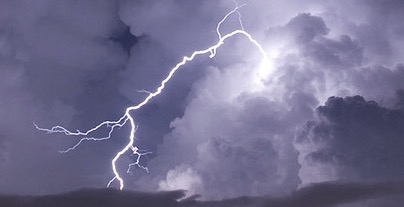Understanding Weather Advisories, Warnings and Terms


Understanding Weather Advisories, Warnings and Terms
COLUMBUS, Ohio – With Spring and Summer, the region typically sees severe weather from storms and even tornadoes. On April 9, 2020 an EF1 tornado touched down in Vinton County according to the National Weather Service. Knowing key terms for weather advisories and warnings along with the appropriate action can be key to keeping you and your family safe.
Although thunderstorms occur year round, they are most prevalent across the state during the spring and summer months. Thunderstorms can produce damaging winds, deadly lightning, large hail, flash flooding and tornadoes. In addition, effects of extreme heat can be exasperated by power outages caused by these storms. The following severe weather terms are defined by the National Weather Service.
The National Weather Service (NWS) is responsible for issuing severe weather watches, warnings and advisories to alert the public when dangerous weather conditions are expected. The Ohio Emergency Management Agency offers information concerning plans for emergency situations as well.
- Watch – A weather watch means there is the potential or conditions exist for a dangerous weather event.
- Warning – A weather warning means that a dangerous weather event is imminent. Immediate action must be taken to protect life and property.
- Advisory – A weather advisory means weather conditions that are less serious than a warning are imminent. These events may cause a significant inconvenience, and if caution is not exercised, it could lead to a situation that may be threatening to life and property.
Hazardous Weather Outlook – Issued daily, a hazardous weather outlook highlights any significant weather conditions that may develop. It is intended to provide information on the potential of significant weather over the next week.
Special Weather Statement – Provides the public with information concerning ongoing weather hazards, including strong storms that may become severe.
Short Term Forecast – A short-term forecast describes the weather in the local area and includes a short-range forecast (usually not more than six hours). This product will be updated more frequently when it is used during active weather. A short-term forecast is sometimes referred to as a “NOW-cast.”
Fire Weather Watch – A fire weather watch is issued when there is the possible development of conditions favorable for forest, grass or brush fires and the conditions support extreme fire danger and/or fire behavior.
Flood/Flash Flood Watch – A flood watch or a flash flood watch can be issued for potential flooding. A flash flood watch is issued for the potential of rapid flooding that is usually caused from torrential downpours, dam breaks or the breakup of ice jams. A flood watch may be issued when the onset of flooding is much slower, usually greater than six hours. The body of the watch describes the cause of the potential flooding and some possible results if flooding were to materialize. The watches are usually issued up to 12 hours prior to the possible flood event.
High Wind Watch – This product is issued when there is the potential of high wind speeds developing that may pose a hazard or is life threatening. The criteria for this watch is the potential for sustained non-convective (not related to thunderstorms) winds greater than or equal to 40 mph and/or gusts greater than or equal to 58 mph.
Severe Thunderstorm Watch – A severe thunderstorm watch outlines an area where hail of 1 inch in diameter or larger, and/or damaging thunderstorm winds are expected to occur. Tornadoes may be possible.
Tornado Watch – A tornado watch outlines an area where conditions are favorable for the development of tornados in and close to the watch area. During the watch, people should review tornado safety rules and be prepared to move a place of safety if threatening weather approaches.
Particularly Dangerous Situation (PDS) Watch – “Particularly Dangerous Situation” is used in rare situations when long-lived, strong and violent tornadoes are possible. This enhanced wording may also accompany severe thunderstorm watches for exceptionally intense and well organized convection wind storms. PDS watches are issued when the likelihood of significant events is boosted by very volatile atmospheric conditions.
WARNINGS
- A warning is issued when a hazardous weather or hydrologic event is occurring, imminent, or has a very high probability of occurring. A warning is used for conditions posing a threat to life or property.
- Action: Take action immediately to protect life and property.
Excessive Heat Warning – An excessive heat warning is issued when heat indexes will generally reach 105 degrees or higher for a period of two hours or more.
Flash Flood Warning – A flash flood warning signifies a short duration of intense or rapid flooding of counties, communities, streams, or urban areas. Flash floods may result from torrential downpours, dam breaks, or the breakup of ice jams.
Action: Take action immediately – move to higher ground, do not drive through flooded roadways.
Flash Flood Emergency – In exceedingly rare situations, when a severe threat to human life and catastrophic damage from a flash flood is imminent or ongoing, the phrase flash flood emergency may be included in a flash flood warning or statement.
Action: Take action immediately – move to higher ground, do not drive through flooded roadways.
Flash Flood Statement – A flash flood statement provides supplemental information on active flash flood warning, such as updated observations and impact information. It will provide the latest information on the flash flooding situation.
Areal Flood Warning – An areal flood warning may be issued for any high flow, overflow, or inundation in a geographical area which threatens life and property and isn’t appropriately covered by a flash flood warning or flood warning for forecast points.
Flood Statement – A flood statement is issued after a Flood Warning. It will provide the latest information on the flooding situation.
High Wind Warning – A high wind warning is issued when sustained winds (not of thunderstorm origin) are predicted to reach 40 mph or greater for at least one hour, or any gust of wind is expected to be 58 mph or greater.
Severe Thunderstorm Warning – A severe thunderstorm warning is issued when large hail or damaging wind is occurring or imminent. Severe thunderstorms can also produce tornadoes with little or no advance warning. Severe thunderstorms will also produce frequent and dangerous lightning and occasionally torrential rainfall.
Action: Seek safe shelter immediately. Criteria: Hail – 1″ or larger; Wind – 58 mph or greater.
Severe Weather Statement – A severe weather statement provides follow-up information on severe weather conditions (severe thunderstorm or tornadoes) which have occurred or are currently occurring.
Special Marine Warning – A product issued for potentially hazardous weather conditions usually of short duration (up to 2 hours) producing sustained marine thunderstorm winds or associated gusts of 34 knots or greater; and/or hail 3/4 inch or more in diameter; and/or waterspouts. It is also used for short duration non-thunderstorm events such as a strong cold front, gravity wave, squall line, etc., lasting less than 2 hours and producing winds or gusts of 34 knots or greater.
Action: Boaters should move to safe harbor.
Red Flag Warning – A red flag warning is issued when favorable conditions exist for forest, grass or brush fires to exhibit extreme fire danger and/or fire behavior. It is a combination of factors consisting of dry fuels, low humidity, and increased winds.
River Flood Warning – A river flood warning is issued for specific communities or points along a river where flooding is imminent or occurring. River flood warnings will provide crest forecasts.
Action: Move to higher ground; do not drive through flooded roadways
Tornado Warning – A tornado warning is issued when a tornado is imminent or occurring. The warning may be issued when a tornado is either indicated by Doppler radar or sighted by trained spotters.
Action: Seek shelter immediately, preferably below ground in a substantial building.
Tornado Emergency– An exceedingly rare tornado warning or statement issued when there is a severe threat to human life and catastrophic damage from an imminent or ongoing tornado. This tornado warning is reserved for situations when a reliable source confirms a tornado, or there is clear radar evidence of the existence of a strong, damaging tornado, such as the observation of debris.
Action: Seek shelter immediately, preferably below ground in a substantial building.
ADVISORIES
- Advisories highlight special weather conditions that are less serious than a warning. They are for events that may cause significant inconvenience and could lead to situations that may threaten life and/or property if caution is not exercised.
Dense Fog Advisory – A dense fog advisory is issued when widespread fog will reduce visibility to one-fourth mile or less.
Heat Advisory – A heat advisory is issued when heat index is expected to reach at least 100°F but less than 105°F.
Urban & Small Stream Flood Advisory – Alerts the public to flooding which is generally only an inconvenience (not life-threatening) to those living in the affected area. It is issued when heavy rain will cause flooding of streets and low-lying places in urban areas. Also used if small rural or urban streams are expected to reach or exceed bank-full. Some damage to homes or roads could occur.
Wind Advisory – A wind advisory is issued when sustained winds are expected to be between 31 and 39 mph for an hour or more, or any instantaneous wind gust between 46 mph and 57 mph is expected.
WEATHER TERMS
Cold Air Funnels
A funnel cloud or (rarely) a small, relatively weak tornado that can develop from a small shower or thunderstorm when the air aloft is unusually cold (hence the name). They are much less violent than other types of tornados.
Derecho
A widespread, fast-moving windstorm associated with convection. Derechos are typically produced by a thunderstorm complex, where the thunderstorms become organized on a scale larger than the individual storms and form a convective system. Derechos can produce damaging straight-line winds over areas hundreds of miles long and more than 100 miles across.
Downburst
A strong downdraft current of air from a thunderstorm, often associated with intense thunderstorms. Downbursts may produce damaging winds at the surface.
Flash Flood
A rapid and extreme flow of high water into a normally dry area, or a rapid rise in a stream or creek above a predetermined flood level, beginning in a short period of time from the causative event. Flash floods typically occur as the result of very heavy rainfall in a short period of time over a relatively small area. It may also be caused by a dam break..
Flood
A condition that occurs when water overflows the natural or artificial confines of a stream or body of water, or accumulates by drainage over low lying areas. This flood is any high flow of water, overflow, or inundation by water which causes or threatens damage.
Funnel Cloud
A condensation funnel extending from the base of a towering cumulus cloud associated with a rotating column of air that is not in contact with the ground – and hence, different from a tornado. A condensation funnel is a tornado, not a funnel cloud if
a.) it is in contact with the ground;
b.) a debris cloud or dust whirl is visible beneath it.
Gust Front
The leading edge of gusty surface winds caused by thunderstorms. Sometimes these winds occur with a roll cloud or shelf cloud and can be quite distant from the originating thunderstorm.
Lightning
A visible electrical discharge produced by a thunderstorm. The discharge may occur within or between clouds, between the cloud and air, or between a cloud and the ground.
Severe Thunderstorm
A thunderstorm producing a tornado and/or, damaging winds of 58 mph or higher, and/or hail 1 inch in diameter or larger. Structural wind damage may imply the occurrence of a severe thunderstorm.
Squall Line
A line of active thunderstorms, either continuous or with breaks, including contiguous precipitation areas resulting from the existence of thunderstorms.
Straight-Line Winds
Generally, any wind that is not associated with rotation, used mainly to differentiate them from tornadic winds. See downburst.
Thunderstorm
A local storm produced by a cumulonimbus cloud, and accompanied by thunder and lightning, strong wind gusts, heavy rain and sometimes hail. A cumulonimbus cloud is a cauliflower-shaped cloud that usually has a height taller than or equal to its width.
Tornado
A violently rotating column of air that comes in contact with the ground, usually, descending from the base of a thunderstorm. In Ohio, many tornadoes are obscured by hills, trees or heavy rain.






